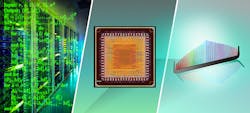Optical frequency combs can make the internet more energy-efficient
At the current rate of data increase on the internet, if no energy efficiency gains were made, within ten years the internet alone would consume more electricity than is currently generated worldwide. In response, researchers at Chalmers University of Technology (Göteborg, Sweden) have completed a five-year research project looking at how to make fiber-optic communications systems more energy efficient.1, 2, 3 Among their proposals are smart, error-correcting data chip circuits, which they have refined to be 10 times less energy consumptive than existing error-correcting chips.
Peter Andrekson, Professor of Photonics at the Department of Microtechnology and Nanoscience at Chalmers, was the leader of the project, called "Energy-efficient optical-fiber communication."
In the early phase of the project, the Chalmers researchers identified the biggest energy drains in today's fiber-optic systems. With this knowledge, they then designed and built a concept for a system for data transmission that consumes as little energy as possible.
Currently, some of the most energy-intensive components are error-correction data chips, which are used in optical systems to compensate for noise and interference. The Chalmers researchers redesigned these chips with optimized circuits.
Optical frequency combs are more energy efficient
At a systemic level, the researchers also demonstrated the advantages of using optical frequency combs rather than having separate laser transmitters for each frequency channel.1 An optical frequency comb emits light at many equally-spaced optical frequencies simultaneously and is very frequency-stable, making reception of the signals much easier and more energy efficient.
Energy savings can also be made through controlling fiber-optic communications at the network level. By mathematically modeling the energy consumption in different network resources, data traffic can be controlled and directed so that the resources are used optimally. This is especially valuable if traffic varies over time, as is the case in most networks. For this, the researchers developed an optimization algorithm that can reduce network energy consumption by up to 70%.
The data chips were designed by Chalmers and manufactured in Grenoble, France. The Chalmers researchers subsequently verified the chips’ performance and measured the energy usage, which was a tenth of current error-correcting chips.
At an energy transfer speed of 1 Tbyte/s, the researchers demonstrated that the chip drew less than 2 pJ per bit of energy; this equates to a power consumption of 2 W at this data rate. Comparatively, the current energy usage at such high transfer speeds is around 50 pJ per bit, or around 50 W.
The 5-year research project ran from 2014–2019 and was financed by the Knut and Alice Wallenberg Foundation.
Source: https://www.chalmers.se/en/departments/e2/news/Pages/Making-the-internet-more-energy-efficient-through-systemic-optimisation.aspx
REFERENCES:
1. Lars Lundberg, et al., Nature Communications (2020); https://doi.org/10.1038/s41467-019-14010-7.
2. Christoffer Fougstedt et al., Journal of Lightwave Technology (2020); doi: 10.1109/JLT.2019.2893039.
3. Mohammad Hadi and Erik Agrell, IEEE/OSA Journal of Optical Communications and Networking (2020); https://doi.org/10.1364/JOCN.11.000578.
About the Author
John Wallace
Senior Technical Editor (1998-2022)
John Wallace was with Laser Focus World for nearly 25 years, retiring in late June 2022. He obtained a bachelor's degree in mechanical engineering and physics at Rutgers University and a master's in optical engineering at the University of Rochester. Before becoming an editor, John worked as an engineer at RCA, Exxon, Eastman Kodak, and GCA Corporation.

